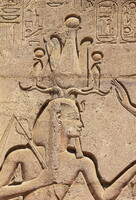Ramesseum
unknown (Egyptian (ancient))

Download1A3-EG-R-C6_cp.jpg (996.1Kb)
Alternative Title
Mortuary temple of Ramesses II
Date
-1279--1260Description
Second court, the northwest inner wall, showing reliefs; Mortuary temple of Ramesses II, on the west bank of the Nile, opposite Luxor temple. For almost a century after the burial of Ramesses II in the Valley of the Kings, this temple served his funerary cult. The most significant event in the Egyptian ritual calendar was the annual festival visit of the god Amun to western Thebes. The god's statue travelled in his ceremonial bark from Karnak to the mortuary temples at the edge of the Western Desert, the Theban necropolis. This event influenced the architectural plan of the 'Ramesseum'. Ramesses adopted the basic design of the mortuary temple of his father Sethos I, which he had completed. The central axis of Sethos' temple is aligned with Karnak temple on the east bank, where Sethos had begun a new monumental approach, the 'Great Hypostyle Hall', which was also completed by Ramesses. The 'Ramesseum', however, is aligned with the first court of Luxor temple, since Ramesses had constructed both the first court and the pylon there. The 'Ramesseum' pylon opened on to a broad court containing one of Egypt's largest free-standing statues. This monolithic granite colossus, originally 18 m in height but now fragmentary, represents the enthroned King and is inscribed with the name 'Ramesses, the sun for (all) rulers'. Source: Grove Art Online; http://www.groveart.com/ (accessed 1/18/2008)
Type of Work
mortuary temple; excavation (site)Subject
architectural exteriors, death or burial, deities, rulers and leaders, Egypt--Religion, Ramses II, King of Egypt, New Kingdom (Egyptian)
Rights
Rights Statement
Licensed for educational and research use by the MIT community only